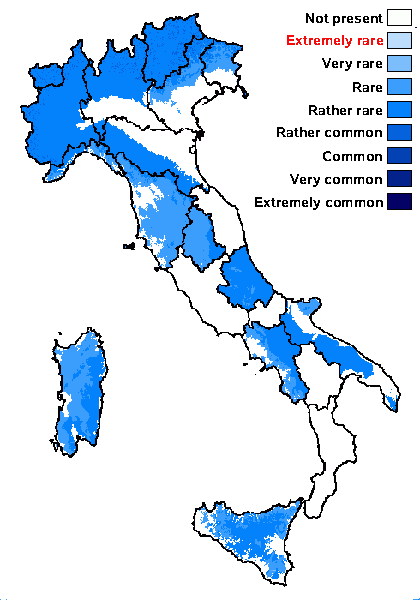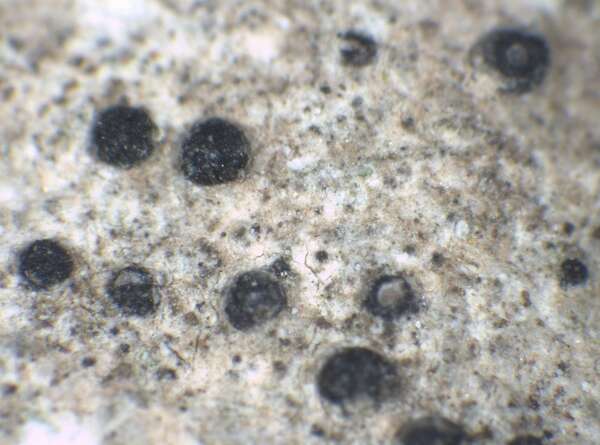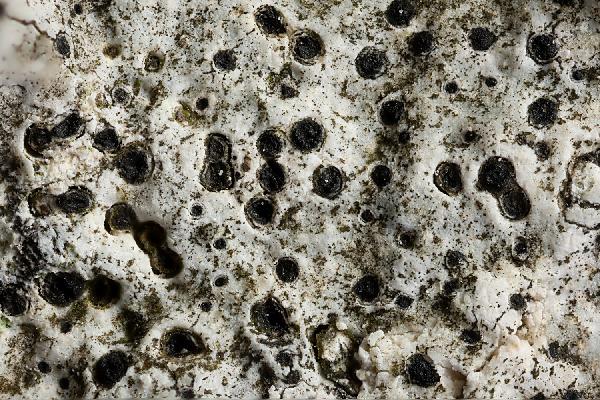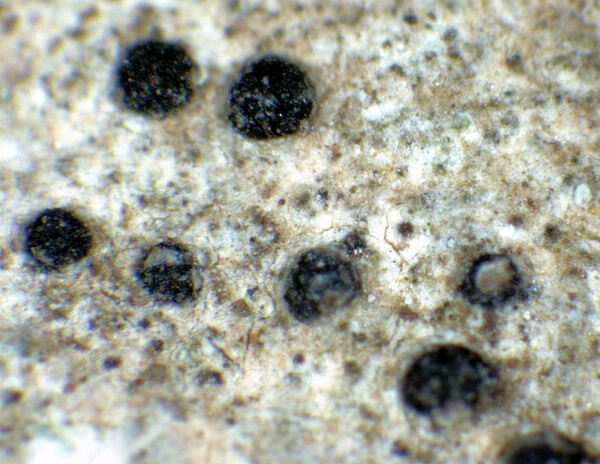Verrucaria foveolata (Flörke) A. Massal.
Ric. Auton. Lich. Crost.: 346, 1852. Basionym: Verrucaria schraderi var. foveolata Flörke - Deutsch. Lich., 2: 6, 1815.
Synonyms: Amphoridium foveolatum (Flörke) A. Massal.; Verrucaria dolomitica auct. non (A. Massal.) Kremp.; Verrucaria latzeliana Servít
Distribution: N - VG, Frl (Breuss 2008 as V. dolomitica), Ven, TAA, Lomb, Piem (Isocrono & al. 2004), VA (Piervittori & Isocrono 1999), Emil (Fariselli & al. 2020), Lig (Giordani & al. 2016). C - Tosc, Umb (Ravera & al. 2006), Abr (TSB 24545), Sar. S - Camp, Pugl, Si (Ottonello & Salone 1994, Grillo 1998, Grillo & Caniglia 2004, Grillo & al. 2007b).
Description: Thallus crustose, seemingly endosubstratic but appearing very thinly episubstratic at high magnification, pale brown to reddish brown, without a distinct prothallus. Perithecia black, (0.11-)0.25-0.35(-0.5) mm across, at least half immersed, projecting with the upper half, the ostiolar region flat or depressed, covered with a thin thalline layer at base, leaving deep pits in the rock when they fall off. Involucrellum absent or very poorly developed around the ostiole; exciple 0.2-0.45 mm across, homogeneously thin or slightly thicker near the ostiole, pigmented throughout, brown to black; hamathecium of branched periphyses and periphysoids measuring (30-)40-65 x 1-2(-3) μm, interascal filaments absent; hymenial gel hemiamyloid, I+ red (I+ blue at very low concentrations of I), K/I+ blue. Asci 8-spored, clavate, I-, fissitunicate, the wall thickened above, with an ocular chamber, dehiscent by extrusion of an endotunica to form a delicate rostrum, Verrucaria-type. Ascospores 1-celled, hyaline, broadly ellipsoid, (20-)22-34(-37) x (10.5-)12-15(-18) μm, with a 1-1.5 μm thick gelatinous perispore. Photobiont chlorococcoid. Spot tests: K-, C-, KC-, P-, UV-. Chemistry: without lichen substances.Note: an ecologically wide-ranging species of compact limestone and dolomite, found both on the top of large boulders and on small pebbles near the ground. It belongs to the poorly understood complex of V. hochstetteri. For further details see Nimis (1993: 738-739).
Growth form: Crustose endolithic
Substrata: rocks
Photobiont: green algae other than Trentepohlia
Reproductive strategy: mainly sexual
Pioneer species
Poorly known taxon in need of further study
Commonnes-rarity: (info)
Alpine belt: rather rare
Subalpine belt: rather common
Oromediterranean belt: rare
Montane belt: rather rare
Submediterranean belt: rather rare
Padanian area: absent
Humid submediterranean belt: rare
Humid mediterranean belt: absent
Dry mediterranean belt: absent

Predictive model
Herbarium samples


P.L. Nimis; Owner: Department of Life Sciences, University of Trieste
Herbarium: TSB (24545)
2003/03/17

Ulrich Kirschbaum CC BY-SA 4.0 – Source: https://www.thm.de/lse/ulrich-kirschbaum/flechtenbilder
Germany; Hesse: Rhön Mountains.
Growth form: Crustose endolithic
Substrata: rocks
Photobiont: green algae other than Trentepohlia
Reproductive strategy: mainly sexual
Pioneer species
Poorly known taxon in need of further study
Commonnes-rarity: (info)
Alpine belt: rather rare
Subalpine belt: rather common
Oromediterranean belt: rare
Montane belt: rather rare
Submediterranean belt: rather rare
Padanian area: absent
Humid submediterranean belt: rare
Humid mediterranean belt: absent
Dry mediterranean belt: absent

Predictive model
| Herbarium samples |


P.L. Nimis; Owner: Department of Life Sciences, University of Trieste
Herbarium: TSB (24545)
2003/03/17

 INDEX FUNGORUM
INDEX FUNGORUM
 GBIF
GBIF
 DOLICHENS
DOLICHENS


